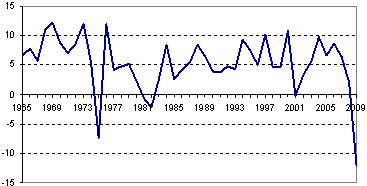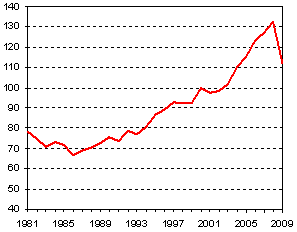The WTO has estimated that global trade would increase by 9.5 percent in 2010. Last year, trade plunged by 12.2%, the sharpest decline since the WWII. The last time global trade volume fell were in 1975 (-7%), 1982 (-2%), and 2001 (-0.2%). Trade in US dollar terms declined even higher (-23%) than in volume terms. Meanwhile, global output fell by 2.3% last year.

Volume of world merchandise exports, 1965-2009 (Annual % change)
Exports from developed countries are expected to increase by 7.5% in volume terms. Meanwhile, shipments for the rest of the world are expected to increase by 11%. This projection is based on the assumptions that global GDP growth would be 2.9% at market exchange rates and the will be stability in oil prices and exchange rates. The WTO warns that a 9.5% growth rate for trade is not sufficient to attain pre-crisis levels of trade volume next year. But, two years of growth at the same rate (12.2%) would surpass the peaks of 2008 for developing countries. The developed countries would require three years of growth at the same rate (9.5%).
The main reason for the sharp fall in global trade was a contraction in global demand. The complex web of supply chains led to a synchronized drop in trade across countries and regions. The source of all these: global recession triggered by the sub-prime mortgage crisis in the US

Ratio of world exports of goods and commercial services to GDP, 1981-2009 (Index 2000=100)
What could dampen the optimistic trade forecasts? The WTO lists increases in oil prices, appreciation or depreciation of major currencies, and additional adverse developments in financial markets as the possible factors that could dampen global trade. But, if the unemployment rates fall quickly, trade could recover faster than expected. [This is not going to happen though, according to economists such as Krugman and Stiglitz because the stimulus packages around the world have not been in proportion to the severity of the crisis.]
Q&A: Fixed Exchange Rate between Nepali Rupee (NRs) and Indian Rupee (IRs)
Following the previous op-ed on the pegged exchange rate between Nepali rupee and Indian rupee, here are some of the questions/ comments raised by readers. The replies are very raw!
Question 1: " Devaluation – a deliberate downward adjustment in the official exchange rate – will reduce the currency’s value. By making exports less expensive, and discouraging imports, devaluation can indeed help reduce current account deficit." less expensive or more expensive ??
Adnan: Once you devalue, one Indian rupee now buys more of Nepali rupees. The exports are now relatively less expensive for foreigners. And imports more expensive for domestic users as it now takes more Nepali rupees to buy one Indian rupee.
Chandan: In other words, devaluation would increase the demand of Nepali goods (i.e. exports less expensive), decrease demand of Indian goods (decrease imports) = net effect would be a positive effect on balance of trade and potentially on balance of payments as well if negative net transfers are not higher than positive net exports.
Question 2: I would think that 'higher interest rates' will increase foreign investment.I agree with the idea of “growing” itself out of this crisis...Also focusing on areas where Nepal has comparative advantage will help.
Adnan: My own thinking has been, for some time now, that money attracted at higher interest rates cannot be loaned at lower interest rates. At the end of the day, any govt wants to provide affordable financing to its small businesses or consumers. In a small and poor country like Nepal, there aren't that many opportunities for businesses to overcome the high hurdle rate and make profit.
One argument can be that govt should subsidize the interest payments which will be "due" to these investors and offer cheaper loans to struggling industries or key sectors like agriculture. But this approach also comes back to bite the govt. Those subsidies will have to be financed by raising taxes. But if the businesses will be taxed through the nose to fund the subsidies, less incentive for businesses to make profits and ultimately less incentive to borrow money from bank. Ultimately, govt do not need to attract those higher interest rate investments. One has to assess the risk appetite of the domestic economy.
In other words, some of these countries may not have the capacity to absorb all these investments.
Chandan: Usually, high interest rates entice "hot money", not foreign investment....
Question 3: What happens if Indian currency switches to fully convertibility ? Government of India is gradually planning to do that ...
Chandan: There are talks about India switching to full currency convertibility. This issues emerged after an Indian mobile company was unable to buy a South African telephone firm primarily due to restrictions on currency convertibility. The Indian finance minister said that they will slowly move in that direction. It will take some time before that happens. Meanwhile, Nepal can still opt to stay with the peg. I think the Indians will have no problem with that. :)
Question 4: Great stuff - though one thing is confusing me. The Marshall-Lerner Condition? Can you help me out?
Chandan: The sum of price elasticity of exports and imports seems to be definitely greater than 1. It means that devaluation might actually improve BOT and, given the conditions I mentioned above, possible BOP. So, M-L condition is satisfied. But, it says nothing about inflation, which is already high. (The J-curve effect also looks applicable in this context.)
Subscribe to:
Comments (Atom)